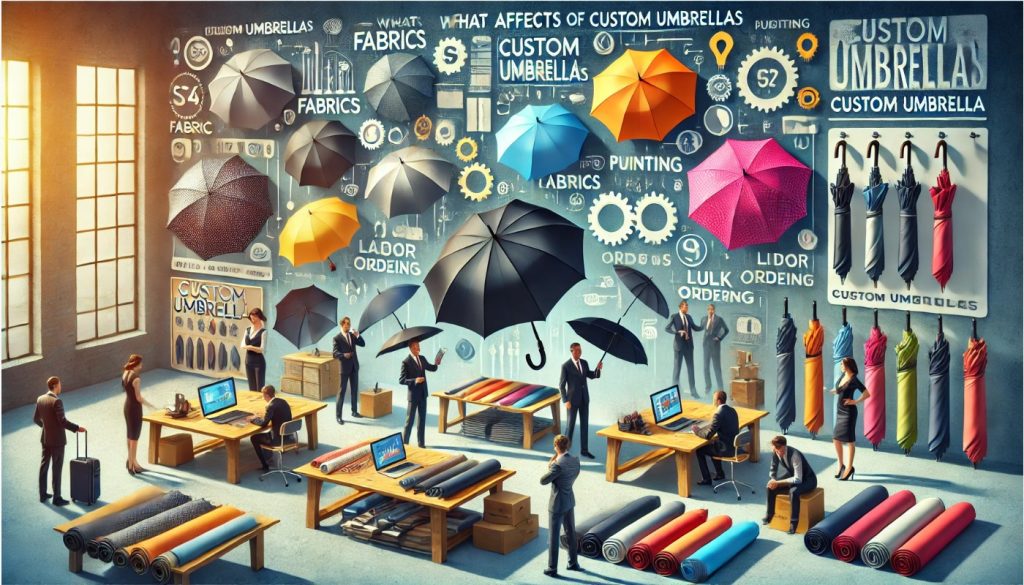Custom umbrellas have become a popular choice for businesses, organizations, events, and individuals who want to make a statement or promote a brand. However, the cost of custom umbrella orders can vary greatly depending on several factors. Understanding what influences the cost of custom umbrella production is crucial for making informed purchasing decisions, especially if you’re a business looking to purchase branded umbrellas in bulk.
Key Factors Affecting the Cost of Custom Umbrella Orders
The price of custom umbrellas depends on several key factors that range from the basic specifications of the umbrella to the complexity of the custom features you want to include. Here, we break down the major aspects that influence the cost of custom umbrella orders:
Design and Style Complexity
The design and style of the umbrella play a significant role in its final price. Custom umbrellas come in a variety of shapes, sizes, and styles, each with its own cost implications. Some designs are straightforward and simple, while others may involve intricate customization that requires advanced techniques.
Customization Level
The level of customization can vary based on your needs. The more detailed the design, the higher the cost. Simple designs may involve adding a logo or text to a plain umbrella, while more elaborate designs could involve custom patterns, artwork, or multiple color printing.
- Basic Customization: This includes adding logos, brand names, or a simple graphic to a pre-designed umbrella. The cost of basic customization is relatively low because it generally requires less work and fewer materials.
- Complex Customization: Includes custom printing across the entire canopy or multi-panel designs, which can be time-consuming and require specialized equipment. Custom patterns, artwork, and full-color prints are typically more expensive due to the precision and labor involved in creating such designs.
- Multiple Print Locations: The placement of the custom design also affects cost. Printing on multiple locations (such as both panels, the handle, and even the tips of the ribs) will raise the overall price due to the extra printing steps.
Umbrella Style and Shape
The style of the umbrella also influences the cost, with certain styles being more expensive than others due to their design and materials.
- Standard Umbrellas: These are usually the most cost-effective option. A basic design with a simple opening and closing mechanism is less expensive to produce.
- Compact Umbrellas: These smaller, foldable umbrellas often cost more because they require more precise engineering and additional components to make them compact and portable.
- Golf Umbrellas: Larger umbrellas, such as those designed for golfing, are generally more expensive due to their size and stronger frame. These require larger quantities of fabric and stronger construction materials.
- Automatic Open/Close Umbrellas: Mechanically complex umbrellas that open and close with the push of a button typically cost more than manual umbrellas because of the added components and engineering involved.
- Specialty Umbrellas: Windproof, UV-protective, and other specialty umbrellas may also incur higher costs due to the unique materials and technology used in their production.
Material Choices
The materials used to manufacture the umbrella are one of the most significant factors affecting cost. Different materials offer different levels of durability, weight, and performance, which all impact the price.
Canopy Material
The fabric used for the canopy (the top portion of the umbrella) plays a major role in both the function and cost of the umbrella. Some common materials include:
- Polyester: This is the most commonly used fabric for umbrellas due to its affordability, durability, and ease of printing. Polyester is a popular choice for custom designs as it holds ink well and can withstand moderate exposure to rain.
- Nylon: Nylon is another popular material, known for being lightweight, water-resistant, and flexible. While it may be more expensive than polyester, it can provide superior water resistance and durability, especially in high-end custom umbrellas.
- Pongee: This is a soft, smooth fabric often used in high-end umbrellas. Pongee fabric provides a more luxurious feel but can increase the cost of the umbrella significantly.
- UV-Protective Fabrics: For umbrellas designed to block UV rays, the fabric often includes special coatings or materials that add to the cost. These umbrellas are more expensive due to the specialized technology and treatment used in the fabric.
Frame Materials
The frame, which supports the canopy and gives the umbrella structure, is made from various materials, each affecting the overall cost.
- Steel: Steel frames are durable and affordable but can be heavy. Steel is commonly used for budget-friendly umbrellas but may not be as long-lasting as more premium options.
- Aluminum: Lighter and more resistant to corrosion than steel, aluminum frames are commonly used in mid-range umbrellas. The added durability and lightweight nature of aluminum increase the cost compared to steel.
- Fiberglass: Known for being flexible and wind-resistant, fiberglass frames are commonly used in windproof umbrellas. While fiberglass frames are more expensive than steel or aluminum, they provide additional durability and performance in harsh weather conditions.
- Wood: Wooden frames are often used for higher-end umbrellas, especially those with a classic or vintage design. Wood can be more expensive than metal frames due to the materials, craftsmanship, and finishing involved.
Handle Materials
The handle material also contributes to the final cost. Simple plastic or rubber handles are less expensive, while custom handles made of materials such as wood, leather, or metal will increase the overall price of the umbrella.
- Plastic: Plastic handles are the most affordable and are common in budget umbrellas.
- Wood: Wooden handles add a touch of elegance and durability, making them a more expensive option.
- Metal: Metal handles, often crafted from materials such as aluminum or steel, can provide a sleek, durable feel but come at a higher price.
- Rubber or Leather: For luxury custom umbrellas, rubber or leather handles provide comfort and a premium appearance but add to the cost.
Printing and Customization Methods
The technique used to apply custom designs to umbrellas greatly influences the overall cost of the order. There are different printing methods, and each comes with its own set of advantages and pricing implications.
Screen Printing
Screen printing is a popular method for custom umbrella designs, particularly for logos or simple graphics. It involves creating a stencil (or screen) and using it to apply ink onto the umbrella fabric. Screen printing is cost-effective for larger quantities and works well for designs that use one or two colors.
- Pros: It’s affordable, durable, and works well for bulk orders.
- Cons: It’s not suitable for complex, multi-colored designs, as each color requires a separate screen and print pass.
Digital Printing
For more intricate designs or multi-colored graphics, digital printing (also known as full-color printing) is often used. This method involves printing the design directly onto the fabric using digital technology. While it offers higher precision and flexibility with complex designs, it is typically more expensive than screen printing.
- Pros: Allows for detailed, full-color images and complex designs. Ideal for low-quantity or one-off custom orders.
- Cons: Higher cost compared to screen printing, especially for large quantities.
Sublimation Printing
Sublimation printing is often used with polyester fabrics and involves turning the ink into gas and bonding it to the fabric. This method allows for high-quality, vibrant, and long-lasting designs. It’s ideal for designs that cover the entire canopy and is typically used for medium to high-end umbrellas.
- Pros: Great for all-over designs, vibrant colors, and high durability.
- Cons: It works best with synthetic fabrics like polyester and can be more expensive for custom orders compared to screen printing.
Embroidery
Embroidery is a technique used for adding logos or small text to umbrella handles, panels, or fabric. While it offers a premium and professional finish, it’s usually more expensive due to the labor-intensive process involved. Embroidery is ideal for high-end custom umbrellas or corporate orders where the logo needs to look elegant and durable.
- Pros: Adds a premium, professional look to logos or text.
- Cons: Higher cost due to labor and setup time, and it’s typically limited to simpler designs.
Order Quantity
The number of umbrellas you order significantly impacts the price per unit. Bulk orders generally result in lower per-unit costs because manufacturers can take advantage of economies of scale, reducing production time, material waste, and setup costs. The larger the order, the lower the price per umbrella, which is why businesses often order custom umbrellas in bulk to save money.
Minimum Order Quantity (MOQ)
Many manufacturers have a minimum order quantity (MOQ) for custom umbrellas. This is the smallest number of units you must order to qualify for customizations, and it can vary depending on the manufacturer and the type of umbrella being produced. Larger orders usually receive discounts, while small orders may be priced at a premium per unit.
Bulk Orders and Discounts
When you place an order for a larger quantity, you may qualify for significant discounts. The cost per umbrella decreases as the production volume increases, allowing you to save on overall expenses. However, businesses that only need a small number of custom umbrellas might not benefit from these economies of scale.
Shipping and Logistics
Shipping costs also contribute to the final price of custom umbrella orders, especially for international shipping. The weight, size, and destination of the order can all influence shipping costs.
- Domestic vs. International Shipping: Shipping custom umbrellas internationally can add significant costs due to customs duties, taxes, and freight charges. Shipping costs can also vary based on how the umbrellas are packaged and whether expedited shipping is required.
- Packaging: The type of packaging used for custom umbrellas can affect both shipping costs and overall pricing. Basic packaging may be less expensive, but custom packaging with branded logos or high-quality materials can increase costs.
Lead Time and Rush Orders
The time frame within which you need the umbrellas will also affect the cost. Custom umbrella manufacturers usually offer different pricing tiers depending on how quickly you need the order completed. Rush orders with tight deadlines often incur additional fees, as they require expedited production and shipping. For non-rush orders, production can be scheduled more flexibly, resulting in lower costs.
Standard Production Time
The production time for custom umbrellas generally varies between 2 to 4 weeks depending on the complexity of the design and order size.
Expedited Orders
For customers who need custom umbrellas urgently, expedited production and shipping services are available but come at a premium.
Understanding the factors that influence the cost of custom umbrella orders can help you make better decisions, whether you’re purchasing for personal use, a corporate event, or as part of a large branding campaign. By considering the style, materials, customization methods, and order quantities, you can find the best balance between price and quality, ensuring you get the most value for your money.







